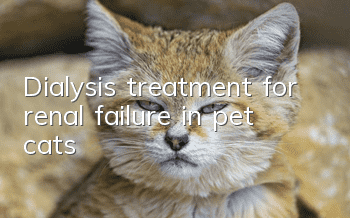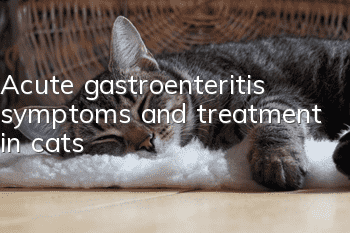Dialysis treatment for renal failure in pet cats

In the treatment of renal failure in cats, in addition to medication and infusion, dialysis is also essential for detoxification in the body. Renal failure affects the filtration function of the kidneys. If nutrients and toxins cannot be filtered out and transported separately in time, into the body and out of the body, will cause further damage to the body. Dialysis is divided into two types: hemodialysis and peritoneal dialysis. A few years ago, peritoneal dialysis has been the main method of dialysis for renal failure. In recent years, with the continuous development of hemodialysis technology, Perfect, hemodialysate is gradually used in medical treatment.
1. Hemodialysis
Hemodialysis (HD) is one of the most effective renal replacement treatments for acute and chronic renal failure, oliguric or anuric nephropathy, and hemodialysis treatment has become the most successful organ replacement treatment in the field of human medicine. However, it is still blank in terms of animals. The purpose of renal replacement therapy is to remove uremic toxins from the blood circulation to prevent their accumulation in tissues. Hemodialysis introduces animal blood and dialysate to both sides of the artificial semipermeable membrane for reverse flow. Through diffusion, convection, Adsorption realizes the movement of solutes on both sides of the semipermeable membrane, and ultrafiltration realizes water removal.
Hemodialysis steps
After the animal wakes up from anesthesia, measure the blood pressure, select the appropriate extracorporeal circulation pipeline and artificial kidney according to the animal's body surface area, and check the concentration of dialysate A and B.
Power-on self-test: Turn on the water treatment switch and perform water treatment pre-flushing. Turn on the dialysis machine and perform machine self-checks as required.
Installation of hemodialysis pipeline: Check that the hemodialyzer and the outer packaging of the blood pipeline are not damaged, and then install them in sequence according to the blood flow direction of the extracorporeal circulation, so that one end is connected to the arterial end and the other end is connected to the venous end. The dialysate pipelines are connected to the inlet and outlet of the dialysate chamber of the dialyzer respectively, and then the artery end section is embedded on the blood pump, and the venous air-catching chamber is fixed, with the venous end of the hemodialyzer facing up.
Pipeline pre-flushing: Start the hemodialysis machine and clean the dialysis pipeline and dialyzer blood chamber gas with normal saline. After normal saline treatment, closed circulation is performed, and finally preflush with heparin saline.
Determine the animal's basic coagulation function test before dialysis, ACT: 108S, check the hemodialysis catheter, use a syringe to check the blood flow and inject the first dose of heparin. Recheck the ACT value after 5 minutes to 262S. After reaching the ideal value, Prepare to draw blood on the machine.
Blood return operation after dialysis is completed: Insert a sterile needle, adjust the blood flow to 2ml/min, turn off the blood pump, clamp the arterial end with a hemodialysis clamp, and connect the arterial end to physiological saline, open the blood pump, and use physiological saline Clamp the venous end after the saline has returned to the blood. Use prepared sterile gauze, elastic bandage, etc. to wrap the surgical site.
2. Peritoneal dialysis
The operation is relatively simple and the cost is relatively lowlower, but the efficacy is equally certain. Metabolic waste and excess retained water in the body are excreted with the used dialysate. By replacing the dialysate intermittently, the purpose of quickly removing toxins and correcting acidosis, dehydration and electrolyte imbalance can be achieved. In layman's terms, peritoneal dialysis is the process of injecting clean fluid into the abdominal cavity and removing the fluid containing toxins from the body. For patients with a cre of around 1000µmol/L before dialysis, the cre can quickly drop to around 400µmol/L after one dialysis session. This can effectively ensure that azotemia is reduced, ion balance and acid-base balance are corrected, and adequate supplementation is achieved before renal function is restored. of water, thereby reducing nephron necrosis and reducing animal mortality.
Peritoneal dialysis can be classified according to the way the dialysate flows and the duration of dialysis. During a dialysis period, the method in which dialysate continuously flows into the abdominal cavity from one catheter and is discharged from another catheter is called continuous dialysis (peritoneal perfusion). This technology is currently not commonly used due to operational difficulties and complex reuse of dialysate. After the dialysate is injected, it stays in the abdominal cavity for a period of time and then is discharged again, which is called intermittent dialysis. There is a time interval between each exchange process of intermittent dialysis, during which the dialysate is drained, so no dialysis occurs. During a short interval between removing the old dialysate and injecting new dialysate, there is always dialysate in the abdominal cavity for continuous dialysis. This method is called continuous dialysis. The time when the dialysate stays in the abdominal cavity for 4-10 hours is called "continuous ambulatory dialysis". The residence time of dialysate during "emergency continuous dialysis" is within 1 hour. The method of always retaining a part of the dialysate in the abdominal cavity, only a part of the dialysate being discharged, and periodically injecting fresh dialysate is called tidal peritoneal dialysis. This technology is considered to be a hybrid model of continuous dialysis and intermittent dialysis, and is more superior than the above two, but it has not been widely used in veterinary clinical practice.
There are two main difficulties in peritoneal dialysis operation:
The first point: the composition of dialysate needs to be prepared according to different dialysis purposes;
The second point: The most difficult thing is that due to the influence of the omentum during dialysis, it makes it difficult to pump liquid. Therefore, when aspirating liquid, be sure to avoid the influence of the greater omentum. This requires a certain amount of experience and will be very convenient to operate. If it is operated by a novice, it may be difficult to extract even 1/4 of the liquid.
Complications of peritoneal dialysis
In peritoneal dialysis treatment of dogs and cats, hypoalbuminemia, peritonitis, catheter obstruction or dialysate retention are the most common complications. Most of these complications are controllable.
The end of dialysis treatment
It is best to continue dialysis until kidney function returns to normal, so that the animal can survive without relying on dialysis. If you leave dialysis treatmentIf the renal function of the treated animal is insufficient to sustain life, euthanasia should be considered. After several days of treatment, even if the dialysis proceeds smoothly, the animal's quality of life has not improved to an acceptable level, and the dialysis treatment should be terminated. Such situations include the animal's biochemical indicators not improving or despite the azotemia. The severity of the disease is reduced, but the clinical symptoms are not relieved, and there is uncontrollable peritonitis.
- Adverse symptoms of cats after vaccination
- Cat behavior before giving birth
- Can pet cats be brought on the high-speed train? What is the process for shipping cats?
- How to check the health of your cat? A guide to home check-ups for cats!
- What should I do if my cat likes to scratch the sofa? How to change your cat’s habit of scratching the sofa?
- How many months can a female cat gradually become pregnant?
- Are American Shorthair cats easy to raise? American Shorthair cats’ appearance characteristics and introduction
- How to induce lactation in Garfield cats
- What causes premature birth in cats? Causes of premature birth in cats
- Why does the cat’s body twitch?



